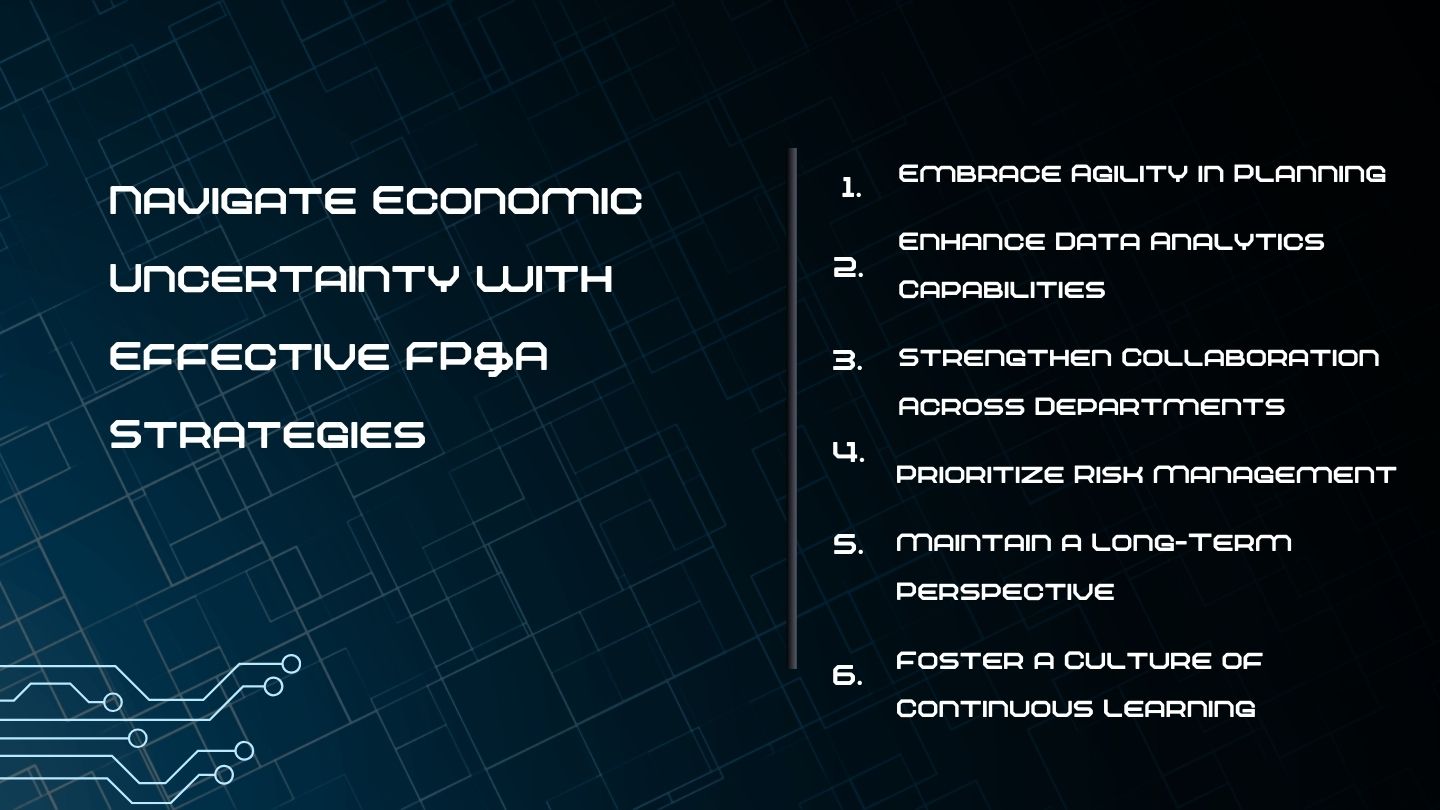Navigate Economic Uncertainty with Effective FP&A Strategies
Economic uncertainty is a reality that organizations face regularly, whether due to market fluctuations, geopolitical events, or unexpected global crises. For FP&A (Financial Planning and Analysis) professionals, navigating these turbulent waters requires agility, foresight, and robust strategies. In this article, we will explore effective FP&A strategies that can help organizations adapt their planning and forecasting methods during times of economic uncertainty.

1. Embrace Agility in Planning
Flexible Budgeting
In times of uncertainty, adopting a flexible budgeting approach allows organizations to adjust their financial plans more easily. Instead of rigid annual budgets, consider rolling forecasts that can be updated quarterly or even monthly. This method enables FP&A teams to incorporate the latest data and adjust assumptions based on real-time market conditions.
Scenario Planning
Developing multiple scenarios—best case, worst case, and most likely case—can provide valuable insights into how different economic conditions might impact the organization. By preparing for various outcomes, FP&A professionals can help management make informed decisions that account for potential risks and opportunities.
2. Enhance Data Analytics Capabilities
Invest in Advanced Analytics Tools
Utilizing advanced analytics tools can help FP&A teams gain deeper insights into financial data. Incorporate predictive analytics and machine learning algorithms to identify trends and forecast potential outcomes. These tools can enhance accuracy in projections, even amid fluctuating conditions.
Focus on Real-Time Data
Real-time data access is crucial during uncertain times. Implement dashboards that provide up-to-the-minute information on key performance indicators (KPIs) and financial metrics. This visibility allows FP&A professionals to respond quickly to changing circumstances and adjust forecasts accordingly.
3. Strengthen Collaboration Across Departments
Foster Cross-Functional Communication
During periods of economic turbulence, communication between departments becomes even more critical. Establish regular touchpoints with key stakeholders across the organization, including sales, marketing, and operations. This collaboration ensures that all teams are aligned and can provide insights that inform financial planning.
Engage in Bottom-Up Forecasting
Involving employees from various departments in the forecasting process can yield more accurate projections. Encourage teams to share their insights and perspectives on market conditions and operational challenges. This bottom-up approach not only improves accuracy but also fosters a sense of ownership and accountability.
4. Prioritize Risk Management
Identify Key Risks
Conduct a thorough risk assessment to identify potential threats that could impact the organization’s financial performance. Focus on both internal risks (e.g., operational inefficiencies) and external risks (e.g., economic downturns). Understanding these risks helps FP&A teams incorporate them into their planning and forecasting models.
Develop Contingency Plans
Having contingency plans in place is essential during uncertain times. Outline strategies for various risk scenarios, detailing how the organization will respond to different challenges. This preparedness can help minimize disruptions and ensure business continuity.
5. Maintain a Long-Term Perspective
Balance Short-Term and Long-Term Goals
While it’s essential to respond to immediate economic challenges, FP&A professionals should not lose sight of long-term strategic goals. Ensure that the planning process incorporates both short-term adjustments and long-term vision, allowing the organization to remain focused on sustainable growth.
Regularly Review and Adjust Strategic Plans
In volatile environments, organizations should regularly revisit and adjust their strategic plans. Conduct periodic reviews to assess whether current strategies remain relevant and aligned with evolving market conditions. This flexibility can position the organization for success in both the short and long term.
6. Foster a Culture of Continuous Learning
Encourage Professional Development
Economic uncertainty often presents opportunities for learning and growth. Encourage FP&A professionals to engage in continuous education and professional development. Staying updated on industry trends, best practices, and new technologies can enhance the team’s ability to adapt to changing circumstances.
Share Knowledge and Best Practices
Create a platform for sharing knowledge and best practices within the FP&A team and across the organization. Regularly discuss lessons learned from previous economic downturns or uncertainties to foster a culture of learning and resilience.
Conclusion
Navigating economic uncertainty requires FP&A professionals to adopt effective strategies that enhance planning and forecasting methods. By embracing agility, leveraging advanced data analytics, fostering collaboration, prioritizing risk management, maintaining a long-term perspective, and encouraging continuous learning, organizations can better position themselves to weather economic storms. As uncertainty becomes a more frequent part of the business landscape, these strategies will be critical for achieving sustained financial performance and strategic success.
